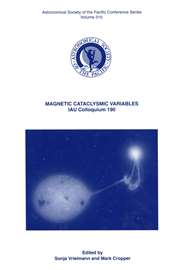No CrossRef data available.
Article contents
Solar and Stellar Flare Observations using Watch
Published online by Cambridge University Press: 27 September 2017
Abstract
Core share and HTML view are not available for this content. However, as you have access to this content, a full PDF is available via the ‘Save PDF’ action button.
The Danish experiment WATCH (Wide Angle Telescope for Cosmic Hard X-rays) is to be flown on board the Soviet satellite GRANAT in middle of 1989. The performence characteristics of the WATCH instrument is described. It is estimated that WATCH can detect about 100 solar hard X-ray bursts per day. WATCH can also detect about 40 energetic stellar soft X-ray flares, similar to the fast transient X-ray emissions detected by the Ariel V satellite.
- Type
- Session I: Stellar Flares
- Information
- International Astronomical Union Colloquium , Volume 104 , Issue 2: Solar and Stellar Flares , 1989 , pp. 33 - 36
- Copyright
- Copyright © Kluwer 1989
References
Haisch, B.M., 1983, In “Activity in Red-Dwarf Stars”, IAU Symp. no. 71, eds: Byrne, P.B. and Rodono, M.. D.Reidel Publ. Comp., p255
Google Scholar
Lin, R P., Schwartz, R.A., Kane, S.R., Pelling, R.M. and Hurley, K.C., 1984, Ap.J., 283, 421
CrossRefGoogle Scholar


